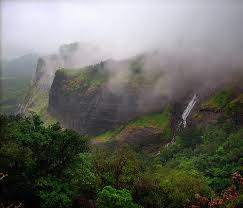Harishchandragad fort is quiet ancient, with its origin dating
back to the sixth century. There are caves situated all over the fort, believed
to be carved out in the eleventh century. The various temples and carvings in
the caves indicate that the fort belongs to the medieval period, since it is
related to Shaiva, Shakta or Naath. Later, the fort was under the control of
the Moguls. And by 1747, the Marathas captured it.
The cave of
Kedareshwar hosts a big Shivlingam, which is surrounded by water. The lingam is surrounded by four pillars that
essentially represent the four yugas of life on earth. The general
belief is that the current phase is the Kali
Yuga. The day the fourth pillar breaks down will be considered the
end of this era.
The fort is very popular to trekkers
and nature lovers as it is one of the best forts to trek. Konkan Kada is a
challenge for trekkers as it is at a height of 3,500 feet. Rohidas, Taramati
and Harishchandra are the three peaks in Harishchandragad. Taramati peak is the
highest one in the fort. Many peaks, fort and other beautiful places such as
Malshej Ghat, Jivdhan, Nane Ghat, Ratangad, Kalsubai, etc. can also be seen
from here.
What
to see on the fort:
·
KEDARESHWAR
CAVE - This temple is marvelous example of the fine art of carving sculptures
out of stones that prevailed in ancient India. The river Mangal Ganga is said
to originate from one of the tanks located close to the temple.
·
KONKAN
KADA - A huge cliff at Harishchandragad which offers spectacular view of Konkan
and also the sunset.
·
OTHER
CAVES - There are many caves on this fort.
·
KEDARESHWAR
CAVE: In this cave there is a Shivlinga which is surrounded by ice cold water.
During rainy season this cave is not accessible as there's lot of water in the
surrounding area.
·
TARAMATI
PEAK: Also known as Taramanchi. This is the topmost point on the fort. It is
the 2nd highest peak in Maharashtra. Leopards are seen in the forests beyond
this peak. From here we can have a glimpse of the whole range of Naneghat and
the forts near Murbad.































































